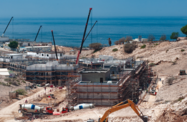Increased private sector participation in Oman’s project pipeline, and draft bills to ease workforce restrictions and allow 100% foreign ownership, look set to help drive continued expansion in the country’s construction sector over the medium to long term.

The government’s development plan for 2016-20 – the final component of its Vision 2020 long-term blueprint for economic diversification – allocates state development spending of OR1.66bn ($4.3bn) per year for a range of projects, such as a waterfront complex at Port Sultan Qaboos, a new international airport terminal in Muscat and a national railway system. A recent pick-up in investment activity reflects the plan’s call for an enhanced private sector role in ownership, financing and management of such undertakings.
According to the latest full-year figure from the National Centre for Statistics and Information, construction activity contributed OR2.1bn ($5.46bn) to GDP at constant prices in 2015, a 10% increase on the previous year.
Private sector steps up
At the end of March, Oman’s Ministry of Tourism inked an agreement with Quriyat Development Company to build the OR385m ($1bn) Quriyat Tourism Complex on the country’s eastern coast.
The project – to be funded by the private sector – will be carried out in three five-year phases, with the first slated to finish in 2021. Upon completion in 2031, the development will have a nine-hole golf course, three hotels, a marina, and commercial and residential complexes.
March also saw the launch of another integrated tourism complex, the Al Mina Residences and Yacht Club development, where construction is to begin by the end of this year and finish by 2020. Upon completion, Al Mina will feature 69 new residential units and a yacht club at Jissah Bay in Muscat.
While the Quriyat complex will be located near the relatively unknown town of Quriyat, Al Mina is part of the exclusive Barr Al Jissah destination, and builds on existing demand for villas, penthouses and duplexes.
New momentum behind the tourism sector is supported by Tanfeedh, a government scheme to help implement the five-year plan’s goals launched last September, in which tourism is identified as one of five growth pillars alongside manufacturing, logistics, finance and employment.
Work begins on large mall
In the retail sector, construction began in mid-March on Mall of Oman, a 135,000-sq-metre space that will become the largest mall in the country when it opens in 2020.
The mall – designed by US-based construction consultancy AECOM and being developed by Dubai-based holding company Majid Al Futtaim – is expected to host 350 retail outlets alongside cinemas, a snow park and a family entertainment centre. The site is located at Madinat Al Ifran, a new business hub under development near Muscat International Airport.
Coming regulatory changes
Construction of the numerous projects could be further supported by an easing of “Omanisation” workforce restrictions, which require firms to hire minimum quotas of Omani nationals, at different levels for various sectors.
In December the Oman Society of Contractors (OSC) drafted a proposal to lower the mandatory Omanisation rate from 30% to 10% for the construction industry. Shahswar Al Balushi, CEO of OSC, told local media in March that the sector’s actual Omanisation rate was 7% despite the legally required minimum – a gap that suggests uneven enforcement and could deter potential investors and contractors looking to enter the market.
According to Al Balushi, the draft law is in advanced stages of approval and is likely to come into effect before the end of June. Under the terms of the proposal, the rate of Omanisation would then be increased gradually over the next three years to reach 15% by 2020.
An official relaxing of legal hiring restrictions would mean contractors could better help the government reach its long-term development goals without being subject to challenging constraints on human capital. Contractors have historically struggled to fill quotas due to inadequate numbers of Omanis seeking to work in the sector, according to the OSC.
Such changes could be a boon for the construction sector, which is the largest employer in Oman, providing jobs for 39% of foreign workers and 25% of all Omani private sector staff, according to official data as of July 2016.
A further boost could come with passage of a bill to lift restrictions on foreign ownership, which as of February last year was reportedly in the final drafting stage. Devised with consultation from the World Bank, the proposed new law would raise the cap on foreign ownership of firms from 35% to 100%, and abolish the minimum capital requirement of OR150,000 ($390,000).


